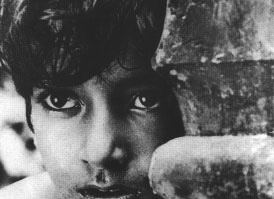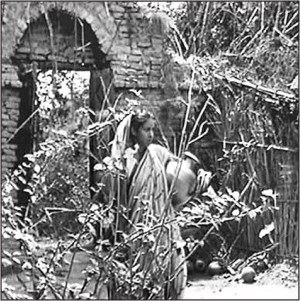“The raw material of the cinema is life itself. It is incredible that a country which has inspired so much painting and music and poetry should fail to move the moviemaker. He has only to keep his eyes open, and his ears. Let him do so.”
 Apu and Aparna, the greatest part of the film is unquestionably towards its end. Apu, weary from years of drifting (in a state of anger and confusion over the death of his wife during childbirth), journeys to a village, where his young son is being cared for. With each step Apu takes, we celebrate his return to nature. The concrete structures of his old way of life fall away and he begins a new path of rediscovery of the joys and simplicity of the natural world. Apu's years of disappointment, tragedy, suffering fall to the wayside as we have come full circle with him, back to the world of his childhood in Pather Pancheli. The texture and poetry of the elements are beautifully caught by the extraordinary lilting camera work. But even this is outshined by the transcendent glow on Apu's face, especially as he reaches the clearing and stands before the power of the light of the sun. In its stark simplicity, this scene represents one of the finest moments ever of cinematic transcendence: just a man before his God.
Apu and Aparna, the greatest part of the film is unquestionably towards its end. Apu, weary from years of drifting (in a state of anger and confusion over the death of his wife during childbirth), journeys to a village, where his young son is being cared for. With each step Apu takes, we celebrate his return to nature. The concrete structures of his old way of life fall away and he begins a new path of rediscovery of the joys and simplicity of the natural world. Apu's years of disappointment, tragedy, suffering fall to the wayside as we have come full circle with him, back to the world of his childhood in Pather Pancheli. The texture and poetry of the elements are beautifully caught by the extraordinary lilting camera work. But even this is outshined by the transcendent glow on Apu's face, especially as he reaches the clearing and stands before the power of the light of the sun. In its stark simplicity, this scene represents one of the finest moments ever of cinematic transcendence: just a man before his God.
 Satyajit Ray is widely regarded as one of the greatest auteurs of 20th century cinema. Akira Kurosawa, the great Japanese filmmaker declared, “Not to have seen Cinema of Ray means existing in the world without seeing the Sun or the Moon.”
Satyajit Ray is widely regarded as one of the greatest auteurs of 20th century cinema. Akira Kurosawa, the great Japanese filmmaker declared, “Not to have seen Cinema of Ray means existing in the world without seeing the Sun or the Moon.”
The great artiste like all of us had a childhood, which was not so smooth. He lost his father when he was barely three. He was born on May 2, 1921 in an intellectual and affluent family in Kolkata. Though their ancestry can be traced back at least 10 generations, (originating from Mymensingh) the family history took a decisive turn with his grandfather Upendra Kishore Ray Chowdhury. He was a writer, illustrator, philosopher, musician and publisher -- a true Renaissance's man, a pioneer in half-tone block making and had one of the finest presses in the subcontinent. He published a children's magazine called Sandesh -- a curious duality in name meaning both “news” and a particular kind of “sweet”. Satyajit later revived Sandesh, set the tone of the magazine both educational and entertaining and engaged himself in illustrating the magazine, and writing stories and essays for children.
Sukumar Ray, son of Upendra Kishore, had been sent to England to study printing technology. He passed with flying colours, returned home, got married and joined his father's business. He was amongst the most renowned Bengali writers of children's literature, an able illustrator and a critic. Sukumar Ray died at the age of 36. The printing press changed hands and Satyajit and his mother Suprabha Ray (Das) had to leave their spacious house and move in with Satyajit's maternal uncle. His mother taught needlework at a widow's school to supplement the household income and until eight years of age, Satyajit was tutored by his mother.
While at school he became a film enthusiast, regularly reading Hollywood trivia on magazines like Picturegoer and Photoplay. Deanna Durbin of Hollywood became his favourite not only because of her looks and her gift as an actress but of her lovely soprano voice. Western classical music was another of his interests. When in College his interest from actors shifted to the filmmakers. Russian filmmaker Podovkin's two books on films changed his vision.
Besides films, he passionately loved music. He grew up in an atmosphere of Indian music. He graduated at the age of eighteen. He became a subscriber of Sight and Sound and sought after film magazines published in England. As he had a natural flair for drawing he was planning to become a commercial artist. On his mother's insistence and his respect for Tagore he enrolled in Shantiniketan in 1940. He spent three years there. The experience was an eye-opener for him, as it exposed the magnificence of Oriental art. He learnt much from the famous painter Nandalal Bose and Binode Behari Mukherjee.
Another important aspect in Shantiniketan for the city-bred Satyajit was getting to know the charms of rural Bengal very closely for the first time.
Ray left Shantiniketan in 1943 and took a job with a British advertising agency DJ Keymer. While at Keymer, Satyajit became involved with Signet Press, a new publishing house started by DK Gupta. The books published from Signet created sensation in the publishing world. Satyajit was given the job to design book covers. In 1944, for the young readers, DK decided to bring out an abridged edition of Pather Panchali by Bibhuti Bhusan Banerjee. DK gave Satyajit the original book of Pather Panchali to read because he was assigned to illustrate for the abridged version.
The book was an eye opener for Satyajit. He discovered with admiration that the book was like an encyclopaedia on life in rural Bengal. The life-like portrayals, the vivid details of day-to-day existence, the humanism, the warmth, everything together seemed like a classic to young Satyajit. It was DK who told him that it would make a very good film. In addition to designing the cover, he illustrated the book, many of his illustrations ultimately found their place as shots in his ground breaking film.
Satyajit along with some of his friends founded the Calcutta Film Society in 1947. In 1949 he married his cousin (maternal) and longtime sweetheart Bijoya Das. One of the most dramatic events in his life was meeting Jean Renoir in 1949 who came to Kolkata to shoot The River. He helped Renoir to find locations in the countryside. It was then that Satyajit told Renoir about his idea of making Pather Panchali. During this time, Satyajit was carrying a notebook filled with sketches, dialogue and the treatment of making a film on Pather Panchali. He wanted the film to be shot in actual locations with new faces without any make-up. The reaction to this from his friends was negative. Shooting in locations with unknown actors was thought to be a totally unfeasible idea.
In the following six months while he was staying abroad, Satyajit saw about a hundred films including Vittorio De Sica's Bicycle Thieves. This film made a profound impact on Satyajit. The film had re-confirmed his conviction that it was possible to make realistic cinema with and an almost entirely amateur cast and shooting at actual locations. On his return journey to Kolkata by ship he had completed his treatment of Pather Panchali. The script was ready at last.
Satyajit started shooting for the film in late 1952 using his personal savings and taking loan from his relatives as none of the producers came forward to fund the film. He had to sell his wife's jewellery to continue with the shooting. Thanks to a loan from the West Bengal Government, the film was finally completed. Pather Panchali was shot over an unusually long period of three years because shooting progressed only when Satyajit could arrange fund.
The film was released in 1955 to great critical and popular success sweeping up numerous prizes and having long runs in both India and abroad. The film had been recognised by the critics and filmmakers all over the world as the “Best Human Document.” Pather Panchali won 11 International prizes and established Satyajit as one of the greatest filmmakers of the world (Shantanu Biswas, December 7, 2007).
Apu and Aparna, the greatest part of the film is unquestionably towards its end. Apu, weary from years of drifting (in a state of anger and confusion over the death of his wife during childbirth), journeys to a village, where his young son is being cared for. With each step Apu takes, we celebrate his return to nature. The concrete structures of his old way of life fall away and he begins a new path of rediscovery of the joys and simplicity of the natural world. Apu's years of disappointment, tragedy, suffering fall to the wayside as we have come full circle with him, back to the world of his childhood in Pather Pancheli. The texture and poetry of the elements are beautifully caught by the extraordinary lilting camera work. But even this is outshined by the transcendent glow on Apu's face, especially as he reaches the clearing and stands before the power of the light of the sun. In its stark simplicity, this scene represents one of the finest moments ever of cinematic transcendence: just a man before his God.
Satyajit Ray is widely regarded as one of the greatest auteurs of 20th century cinema. Akira Kurosawa, the great Japanese filmmaker declared, “Not to have seen Cinema of Ray means existing in the world without seeing the Sun or the Moon.”